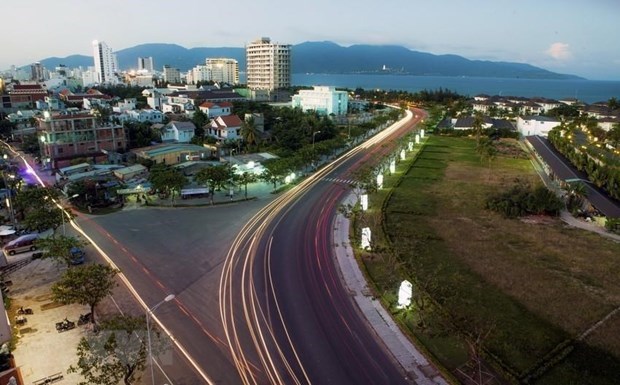Da Nang calls for 587.3 million USD in investment in IZs
 A corner of Da Nang (Photo: VNA)
A corner of Da Nang (Photo: VNA)Da Nang (VNA) - The Da Nang Hi-Tech Park and Industrial Zones Authority (DHPIZA) has offered bidding documents for preliminary selection of investors for infrastructure development of three industrial zones in 2020-2023.
DHPIZA’s head Pham Truong Son said the international bidding will help seek eligible domestic and foreign investors developing infrastructure works on two new industrial zones (IZs) of Hoa Nhon, Hoa Ninh, and the second stage of Hoa Cam IZ on total 880ha with an estimated investment capital of 13.8 trillion VND (587.3 million USD).
He said the IZs have been designed as ‘green’ and ‘clean’ IZs, calling for hi-tech and environmentally-friendly industries in 2020-2023.
The bidding of the three projects will open for all qualified investors on May 28, and the winners would commence construction later this year.
To date, the Da Nang Hi-Tech Park and six other industrial zones have drawn 505 projects worth 2.6 billion USD. These projects earned revenue of 35.6 trillion VND (1.51 billion USD) in 2019, contributing 213 million USD to the local budget.
Foreign investors pumped nearly 700 million USD into the city last year, according to the municipal Department of Planning and Investment.
Of the total, about 440 million USD was invested in 132 newly-licensed projects during the year, eight times higher than one year ago, while 120 million USD was added to 16 operating projects, 63 times higher than 2018’s figure.
During the year, foreign investors also spent 135.3 million USD on capital contribution and share purchase in domestic enterprises, nearly triple that of 2018.
In addition to foreign-invested projects, the city last year also granted in principle approval for nine domestically-financed projects, worth 8.82 trillion VND. That brought the number of projects in the locality up to a value of more than 104 trillion VND.
This year, the city will concentrate on developing technical infrastructure of industrial zones and clusters and fostering investment promotion targeting foreign businesses who will invest in the city’s key sectors, such as IT and supporting industries.
In order to continue luring investment, the city will deploy a number of key projects such as an overall development plan for Da Nang Hi-Tech Park; one-stop shop model for the preparation, licencing and management of investment projects outside industrial parks and hi-tech zones and the improvement of hi-tech innovative features and hi-tech start-ups.
The city also focuses on promoting activities and events which effectively approach strategic investors in key markets, such as Japan, the Republic of Korea, Singapore, the US and Europe.
Da Nang will effectively realise its master plan till 2030 with a vision to 2045, complete procedures to hold land auctions for projects in the fields of health care, education, trade and services during the first quarter of next year.
The city will also call for domestic and foreign investment to high-tech, industrial and smart urban areas.
Prime Minister Nguyen Xuan Phuc has approved adjustments to the master plan on socio-economic development in Da Nang until 2020 with a vision to 2030, under which the central city will become one of the major socio-economic hubs in Vietnam and Southeast Asia.
Under this plan, Da Nang will develop towards an ecological, modern and smart city with its own identity. It will obtain fast and sustainable economic growth; promote people’s living standards to a high level; and focus on developing the three main pillars of tourism; hi-tech industry and sea-based economic activities; and ensuring defence, security, maritime security, and social order and safety.
In addition, the city has set a target of becoming a centre for start-ups, innovation, tourism, trade, finance, logistics, and information technology; and one of the major centres for culture, sports, education and training and health in the country.
The plan targets the city’s annual economic growth rate of 8 – 9 percent between 2016 and 2020, services making up 64 – 65 percent of the local economy while industry – construction 33 – 34 percent and agriculture 1 – 2 percent. The local population is set to reach some 1.6 million in 2020. Meanwhile, the employment rate is expected to rise by 4 – 5 percent each year during the 2016 – 2020 period, with trained labourers accounting for more than 50 percent of the total this year.
For 2021 – 2030, it looks to achieve average annual economic growth of 12 percent, with the services sector accounting for 67 – 68 percent of the economic structure, industry and construction 31 – 32 percent, and agriculture 1 percent./.












